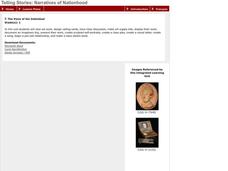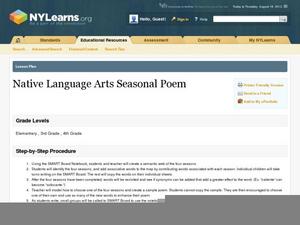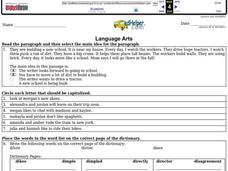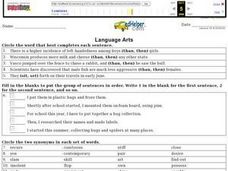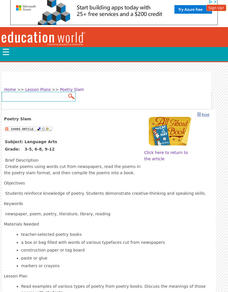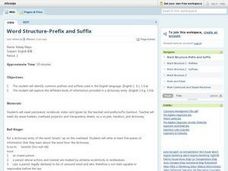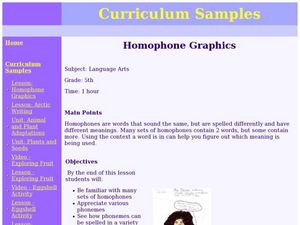Curated OER
The Voice of the Individual
Young learners explore the role of the individual within society. They view art work, design calling cards, and display their work. Additionally, learners document an imaginary trip, create sculpted self-portraits, create a class play, a...
Curated OER
Lesson Plan: Finding Your Path
Our art often reflects who we are as individuals and as part of a larger community. The painting Hopi Eagle Dancer reflects the history and culture of the artists who created it. Critical thinkers analyze the piece and then compose a...
Curated OER
Lesson Plan: Letting Go
Why would an artist destroy his own work? Kids examine the Malagan practice of creating and then destroying art. They talk about the cultural and spiritual significance of this practice, as well as how it relates to consumerism in...
Curated OER
Native Language Arts Seasonal Poem
Intended for native Spanish speakers, this plan provides an opportunity to create a class semantic web describing the different seasons and listen to Vivaldi's "Four Seasons." Learners will work together to revise their semantic webs,...
Curated OER
Language Arts Writing Project
Learners practice writing open-ended questions about a specific topic. They use proper grammar and syntax in their questions that are typed into a word processing file. A rubric is included in this lesson plan to help with assessment.
Curated OER
Language Arts
In this literacy worksheet, 5th graders practice putting the sentences into the proper grammar structure, using the correct punctuation, and finding the definitions in the dictionary.
Curated OER
Language Arts
In this literacy worksheet, 5th graders practice putting sentences in order, use words to complete sentences, and rewrite them correctly for the 25 questions.
Curated OER
Language Arts
In this literacy worksheet, 5th graders find the main idea, put the words into the correct sentences, and read the paragraph to increase reading comprehension.
Curated OER
English in Mind Unit 12 Grammar Practice
In this English grammar worksheet, students identify the correct order for a conversation, answer questions in complete sentences, and practice using in/on/at. There are twenty four fill in the blank and short answer questions.
Curated OER
Mythological Word Origins
No wonder the ship was called the Titanic. An investigation of Norse, Roman, and Greek Mythology provides insight into mythological characters and corresponding words in the English language. A close look at roots, prefixes, and suffixes...
Curated OER
Mythological Word Origins
Review myths and the characters therein, connecting them to vocabulary words in the English language today. Begin by searching online for myths and character names. With at least ten names that are familiar English words, students use...
Curated OER
Poetry Slam!
Create poems without writing! Young poets create poems using words cut from newspapers, read their poems aloud, and compile them in a book. This lesson allows the teacher to view each learner's creative process and assess their current...
Curated OER
Poetry Through Digital Storytelling
Bring digital storytelling to your language arts class! To begin, learners select their own topic, such as a poem that reflects a life experience they had or a historical figure who interests them. Then they work to create a storyboard...
Curated OER
Word Structure- Prefix and Suffix
Identify common prefixes and suffixes used in the English language and categorize the different kinds of information provided in a dictionary entry. Learners will write at least five pieces of information that they learn about a word...
BBC
Lug and the Giant Stork - Capital Letters
Capital letters are the star of the show in a wonderful language arts lesson. After a teacher-led demonstration and discussion on capital letters, groups of pupils get together and work on the computer to fix the flashing letters that...
BBC
Dragon Land - Questions
The proper use of the question mark, and how to correctly construct a sentence that is a question, are the two focuses in a wonderful language arts instructional activity. There is a terrific interactive online game that your kids can...
BBC
The Sound Monster - Words That Make Sounds
There are words in the English language that actually make sounds, such as vroom, and, buzz. Here is a clever lesson plan which introduces young readers to these sound-making words. They play an interactive game on the computer that has...
BBC
Floppy and The Puppies - Characteristics
Here is a wonderful online language arts activity for your emerging readers. Learners play an interactive game where they look at two characters who are engaging with each other. They must choose the word from a word bank that best...
Curated OER
Homophone Graphics
Fifth graders create homophones in a group and share them with the class. In this language arts lesson, 5th graders draw a homophone set. Additionally, students create a sentence using the homophone.
Curated OER
Reading Poetry in the Middle Grades
Bring the beauty of "Nothing Gold Can Stay" by Robert Frost to middle school language arts. After learners read a copy of the poem, they follow an instructional sequence that focuses on sound, figurative language, and theme.
EngageNY
Writing: Drafting Body Paragraphs and Revising for Language
Begin the drafting phase of the writing process with a lesson plan focused on logically writing three body paragraphs. Then, revise the writing to make it more formal after a teacher-directed mini-lesson plan. Each paragraph highlights...
Institute for the Professional Development of Adult Educators
Using Context Clues with Signal Words
When you come across an unfamiliar word in a text, do you skip it and move on? Practice using context clues to identify words you don't know with a thorough set of language arts lessons. The resource reinforces close reading and critical...
EngageNY
Analyzing Language, Character, and Theme: World Café Discussion
As part of their study of A Midsummer Night's Dream, class members meet in a drama circle to discuss and role-play scenes from the play. They then engage in an activity called World Cafe, analyzing the characters' actions from the text....
EngageNY
Analyzing Author’s Craft: Analyzing Hillenbrand’s Language Techniques
Young readers take a look at the conditional and subjunctive moods authors use. The Conditional and Subjunctive Mood handout defines the types of moods and gives them examples and practice. They then work with partners to identify...
Other popular searches
- English Language Arts Exam
- English Language Arts Games
- Deaf English Language Arts
- English Language Arts Music
- English Language Arts Heroes
- English Language Arts Skills
- Language Arts English
- English Language Arts Grade 3
- English Language Arts Poetry
- English Language Arts Rating=3
- English Language Arts Unit Sc
- Language Arts or English


